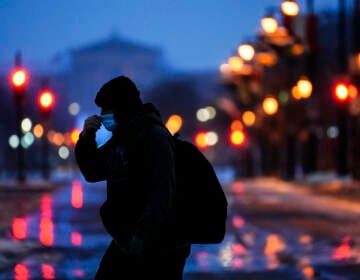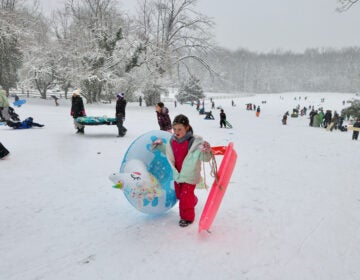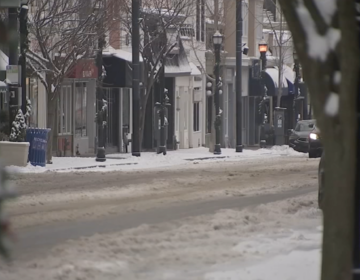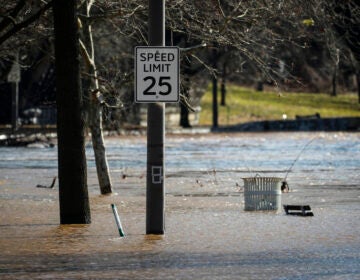Winter storm batters U.S. power, snarling Christmas travel
A battering winter storm has knocked out power to hundreds of thousands of homes and businesses across the United States.
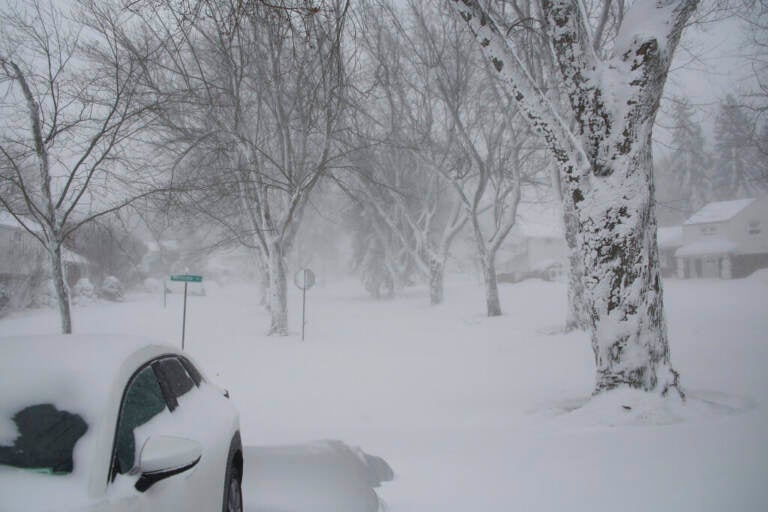
A winter storm rolls through Western New York Saturday, Dec. 24, 2022, in Amherst N.Y. A battering winter storm has knocked out power to hundreds of thousands of homes homes and businesses across the United States on Saturday. It left millions more to worry about the prospect of further outages and crippled police and fire departments. (AP Photo/Jeffrey T. Barnes)
A battering winter storm knocked out power to hundreds of thousands of homes and businesses across the United States on Saturday, left millions more to worry about the prospect of further outages and crippled police, fire departments and an airport in snow-blown New York state.
Across the country, officials have attributed at least 17 deaths to exposure, icy car crashes and other effects of the storm, including two people who died in their homes outside Buffalo, New York, when emergency crews couldn’t reach them amid historic blizzard conditions.
New York Gov. Kathy Hochul said Saturday that the Buffalo Niagara International Airport will be closed through Monday morning and almost every fire truck in Buffalo was stranded in the snow.
“No matter how many emergency vehicles we have, they cannot get through the conditions as we speak,” Hochul said.
Blinding blizzards, freezing rain and frigid cold also knocked out power from Maine to Seattle, while a major electricity grid operator warned the 65 million people it serves across the eastern U.S. that rolling blackouts might be required.
Pennsylvania-based PJM Interconnection said power plants are having difficulty operating in the frigid weather and has asked residents in 13 states to refrain from unnecessary use of electricity. The Tennessee Valley Authority, which provides electricity to 10 million people in Tennessee and parts of six surrounding states, directed local power companies to implement planned interruptions but ended the measure by Saturday afternoon.
Across the six New England states, more than 329,000 electric customers remained without power on Saturday morning, with Maine the hardest hit and some utilities warning it could be days before power is restored. PJM Interconnection, which covers all or parts of 13 states and and Washington, D.C., also warned rolling blackouts might be required.
In North Carolina, 265,000 customers were without power Saturday afternoon, according to poweroutage.us. They included James Reynolds of Greensboro, who said his best friend and housemate, a 70-year-old with diabetes and severe arthritis, spent the morning bundled beside his kerosene heater.
“The bedrooms and much of the house temperatures are hovering in the 50s,” Reynolds told The Associated Press.
In the Buffalo, New York suburb of Cheektowaga, two people died in their homes on Friday when emergency crews could not reach them in time to treat their medical emergencies, according to Erie County Executive Mark Poloncarz.
“This may turn out to be the worst storm in our community’s history,” Poloncarz said Saturday morning. “There are still likely hundreds of people stuck in vehicles.”
Colleen Darby, 59, of Williamsville outside Buffalo, says she had planned to host a Christmas party for family and friends, but the storm will keep her and her daughter at home with a refrigerator full of food.
“I’ve never seen the likes of this kind of storm,” said Darby, a lifelong resident of the area. “I can’t even get out of my house right now. The snow is up to my chest.”
Poloncarz said there is no emergency service available in Buffalo and several populous communities surrounding it because so many emergency vehicles are snowbound. He said a doctor had to talk a woman and her pregnant sister through the delivery of the sister’s baby.
The Christmas weekend storm follows another blizzard that dumped more than 6 feet (about 1.8 meters) of snow in western and northern New York, resulting in three deaths, just over a month ago. New York often sees dramatic lake-effect snow, which is caused by cool air picking up moisture from the warm water, then releasing it in bands of windblown snow over land.
On the Ohio Turnpike, four died in a massive pileup involving some 50 vehicles. A Kansas City, Missouri, driver was killed Thursday after skidding into a creek, and three others died Wednesday in separate crashes on icy northern Kansas roads.
A utility worker in Ohio was also killed Friday while trying to restore power, a company said. Buckeye Rural Electric Cooperative said the 22-year-old died in “an electrical contact incident” near Pedro in Lawrence County.
A woman in Vermont died in a hospital Friday after a tree broke in the high winds and fell on her. Police in Colorado Springs said they found the dead body of a person who appeared to be homeless as subzero temperatures and snow descended upon the region. In Madison, Wisconsin, a 57-year-old woman died Friday after falling through the ice on a river, the Rock County Sheriff’s Office announced.
In Lansing, Michigan, an 82-year-old woman died after being found Friday morning curled up in the snow outside of her assisted living community, Bath Township police reported. A snowplow driver found the woman as temperatures hovered around 10 degrees.
Kentucky Gov. Andy Beshear said one person died in a traffic accident attributed to the weather in western Kentucky and a homeless person died in Louisville.
Along Interstate 71 in Kentucky, Terry Henderson and her husband, Rick, were stuck in a massive traffic jam caused by several accidents for 34 hours. The truck drivers weathered the wait in a rig outfitted with a diesel heater, a toilet and a refrigerator but nonetheless regretted trying to drive from Alabama to their home near Akron, Ohio, for Christmas.
“I wish we should have stayed,” said Terry Henderson, after they got moving again Saturday. “We should have sat.”
The storm was nearly unprecedented in its scope, stretching from the Great Lakes near Canada to the Rio Grande along the border with Mexico. About 60% of the U.S. population faced some sort of winter weather advisory or warning, and temperatures plummeted drastically below normal from east of the Rocky Mountains to the Appalachians, the National Weather Service said.
As millions of Americans were traveling ahead of Christmas, more than 2,360 flights within, into or out of the U.S. were canceled Saturday, according to the tracking site FlightAware. While in Mexico, migrants camped near the U.S. border in unusually cold temperatures as they awaited a U.S. Supreme Court decision on pandemic-era restrictions that prevent many from seeking asylum.
Forecasters said a bomb cyclone — when atmospheric pressure drops very quickly in a strong storm — had developed near the Great Lakes, stirring up blizzard conditions, including heavy winds and snow.
WHYY is your source for fact-based, in-depth journalism and information. As a nonprofit organization, we rely on financial support from readers like you. Please give today.


